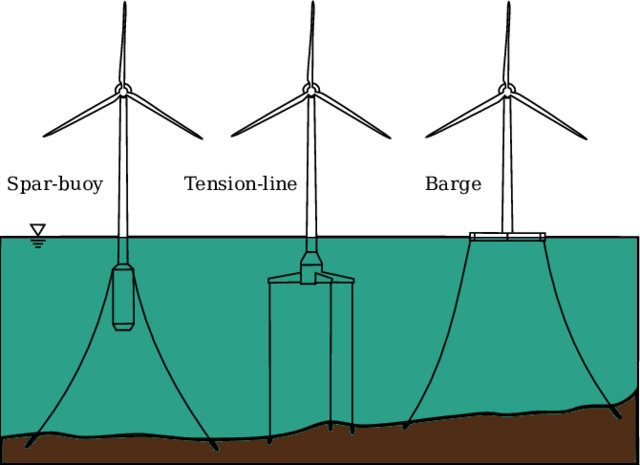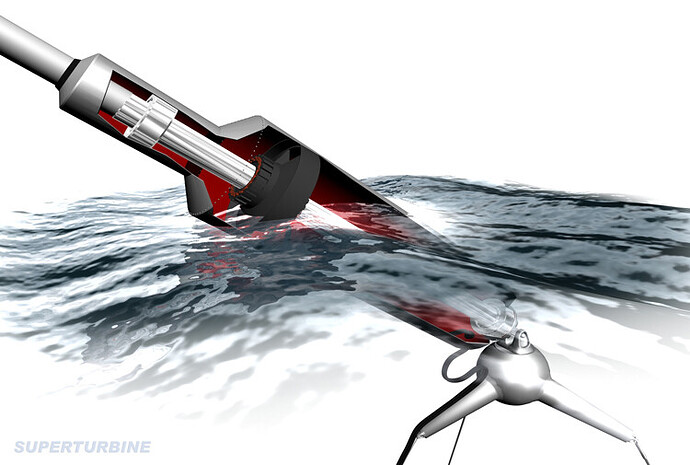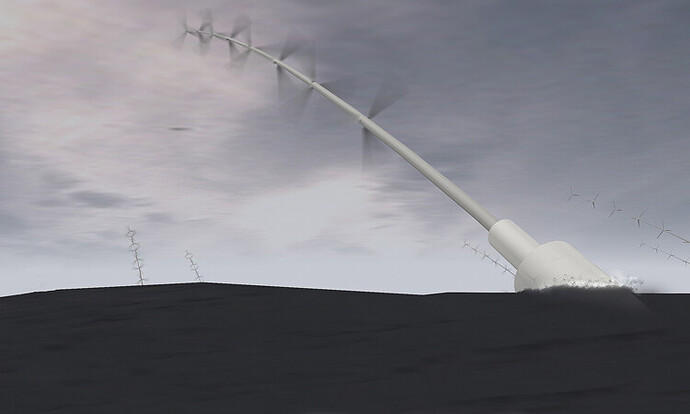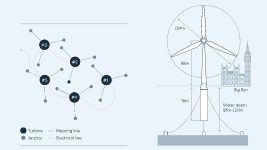Speaking of goofy ideas that will never be built, what ever happened to the stacks of concrete blocks lifted and stacked by a crane, as energy storage? Wasn;t it only in the last year or two we saw this “breakthrough” in so many “news” outlets? Do you think it could store much more energy than a single tesla car battery? At what cost? Was that more “really smart people”? So what happened to that idea? Where is one today? Did someone finally do the elementary school math on it? ![]()
This proposed tilting downwind, co-axial, multi-rotor design, said to be “vertical-axis”, looks a lot like the renderings on my website.
Personally, I doubt if this will ever be built beyond a small prototype, if at all, but it adds one more “press-release breakthrough” to the huge number we’ve already seen.
This is a braindead take. It’s a better developed design that just has some superficial similarities, necessitated by physics.
Uhhh, yeah, coming from an “expert”, no doubt. Hey Windy, can I say your input is “braindead” too, or is that privilege reserved for you alone? Let me just say, the entire floating offshore wind energy industry is now using my design for a base. the “counter-rotating” aspect of WWW has never worked out for anyone, including a predecessor researcher of my SuperTwin and my California Energy Commission-sponsored research. That effort promised a counterrotating dual-rotor machine, but instead just used two separate generators, because, well, they decided the counterrotating feature was too difficult. I had mostly forgotten we’ve seen this design before. It is going nowhere. If you are so knowledgeable as to sit in judgement of everyone elses opinions, might I ask what technological improvements YOU have introduced to the world of wind energy, besides deleting and moving other peoples’ posts? ![]()
If it is, sure, or maybe, it is against the FAQ as it is not very agreeable. Otherwise no. So here you can’t, unless you substantiate that. Look at the features of the two systems and what they look like. I say it is a braindead take to say one is an imitation of the other.
Wouldn’t it be great if things just sprung into existence just by willing it?
In my opinion the comments from Slow Chat II - #62 by dougselsam could enter World Wide Wind topic.
Without going into details, these contra-rotating floating wind turbines look very complex, given the relatively high number of moving parts inherent to this type of rotor, as well as the difficulty of their arrangement.
In my opinion it is a baseless accusation and beyond that doesn’t add to the conversation.
If you like, you can go into detail in the topic.
OK well, there we have it. You who refuse to even identify yourself, who cites no personal contributions to wind energy technology, blatantly violate your own rules, calling my opinion on a turbine design that looks like it came directly from my website “braindead” without substantiation, while saying I can’t say the same thing about your opinion of my opinion.
Here’s how it’s the same as mine:
- Floating, tilting downwind configuration
- Spinning driveshaft
- tubular underwater housing that tilts with the driveshaft above
- generator below waterline to act as counterweight
- multiple coaxial rotors spaced apart on the tilting, spinning mast
- with that spacing allowing fresh wind to reach the next rotor
The foundation is covered by two (2) of my U.S. Patents.
It got named “Spar Buoy” by NREL and has been promoted by them ever since.
That’s just what occurs to me at a glance.
YOU, on the other hand, who it seems to me have probably never designed, built, or run a wind turbine, try to say it is “more developed” than my designs that it weakly imitates, again, without any justification of your statement. No real wind turbine person would say that. Real wind turbine people understand that vertical-axis turbines are almost always a losing idea, that they will shake themselves apart, and that any wind turbine, especially multi-rotor designs, have oscillation issues between rotors. REAL wind turbine people understand that counterrotating generators is an old idea that never caught on, for good reason, and that it wouldn’t allow a “smaller generator for the same power” anyway, because you need a certain amount of copper to handle the power, no matter how you slice it - no free lunch. REAL wind energy people can see at a glance that this is a losing idea, and would never say it is “more developed” than my much simpler and more straightforward and reliable designs, proven in many implementations, including government-funded research. More complicated? Yes. Adding losing features that will ruin it? Yes. More “armchair inventors”, thinking the crap they put on paper will turn out to reflect reality. Nope, the few times these armchair inventors actually build and run any of their nonsense (because they almost never do) are when they quickly see it is all far more complicated already than they ever imagined. They would be standing there dumbfounded after their “masterpiece” shook itself apart in the first decent wind it was exposed to. Now that you said this vertical-axis machine is more developed than my concepts, why not show us a happy owner of a vertical-axis turbine? Or how about showing us a vertical-axis machine that is even still running? Such a concept as thousands of attempts at vertical-axis turbines, including some of the first windfarms that were quickly dismantled after failing, none of which ever worked out, is beyond the comprehension of the armchair inventor contingent. They just see the next V-A rendering and think “Wow, that looks GREAT!”
Reality is not something they take into account. It is all about their fantasies.
Here, to compare the floating offshore concepts, the Spar-buoy (in first), then floating, tilting downwind configurations of both SuperTurbine ™ (secondly) and the discussed contra-rotating floating wind turbine (in third place).
In the same time we can see similarities and differences of the tilted rotors (in 2 and 3).

Note: “discussed”. As opposed to “existing” or “proven”. Where’s even a small prototype verifying the rotor concept, just as a start? Why? If this were your design, wouldn’t you expect to have a working model of any size, before claiming you would be building turbines bigger than any ever built? In that case, why would anyone believe you? They would believe you because they also know nothing about wind energy. The blind leading the blind. ![]()
People just see a rendering and think “Wow, that’s great!”
This appears to be actual news. Supposedly measured independently by Underwriters Laboratories (UL). I’ve always wondered about “cold fusion”, suspecting there might be something to alternative ways to create fusion reactions, besides the “Swatting a fly with a sledgehammer” Tokamaks.
There’s a video in the article showing it working. You can see a blue glow at the center of the unit. Apparently, these researchers have a cheap setup using water as fuel that returns more energy than used to power it. Works on a tabletop, and I don’t see any shielding or extravagant apparatus surrounding the unit.
If this turns out to be true, we could have the “'Mr. Fusion” systems envisioned in “Back to the Future”, powering our cars. And homes. And businesses and industry. The article doesn’t go into a lot of details, and I have no idea HOW this supposedly works, but if it is real, as they say, “it will change things very quickly”. They say it could be in production and on the market in less than two (2) years.
Cheap energy is what makes the world go 'round. We need cheap energy.
If their setup really works as stated, it could open the door to more related methods and setups. They are saying every home could have one!
Before you know it, fossil fuel companies will be paid to add greenhouse gases to the atmosphere to stave off the next glacial cycle! ![]()
I have to say, after seeing so many similar nonoperational, desktop models at trade shows, I’m flagging this article as literally just a bunch of outright lies. I think “journalists” are so used to just writing compelling “stories”, they forget their role is supposed to be to convey facts.
Let’s examine what this article actually says:
- “A wildly innovative turbine” - As far as we know THERE IS NO TURBINE. It doesn’t exist.
- “that could halve the cost of offshore wind” - sure, half the cost - no evidence of that.
- “is set to go into testing in Norway” - really? A supposed turbine that doesn’t exist “is set to go into testing”?
- “The 19-m (62-ft), 30-kW, contra-rotating vertical-axis turbine is a prototype” - I’m pretty sure there IS NO PROTOTYPE, or we would see it. They seem to think providing some dimensions makes it real. Nope, and I’ll guess such a prototype will never be built at all!
- “of a design that could scale to unprecedented size and power.” - sure, you could say that about any sketch or rendering. Where is even the slightest evidence?
Why don;t they have a single-rotor, land-based version of even one kW running to prove their rotor idea even works? Why? because as long as all they have to do is talk talk talk about it, they never have to prove anything, just keep going on about how great it will be (saying how great it IS even though it doesn’t exist)
It seems that of the three concepts using Spar-buoy that I mentioned, Hywind Scotland is the only company to have achieved it.
Something having some similar attributes does not make it an imitation.
Their design looks to be more developed because the shaft is more likely to survive long-term at a bigger scale, and it has a bigger swept area. Or maybe I should say “differently” developed, as it looks to have its own potential problems, like perhaps the contra-rotating rotors, and the bottom rotor that seems to be in danger of hitting the water.
I’ll take back that it looks more developed, that should come after they’ve done some testing on some prototypes.
OK well, thanks for modifying your stance. One more similarity might be a version where the float rotates with the rotating tower/driveshaft, if that is what theirs is supposed to do, which I did not discern.
What I would call possible “Profesor Crackpot” aspects are combining multiple unknowns. The most glaring is introducing a new style of rotor with no testing, not even acknowledging that it’s a total unknown. Like a new rotor style is just some minor detail with no need to test it. The next is adding the unproven counterrotating driveshafts, one inside the other. THEN adding a counterrotating generator, which, being located below the surface in salt water, could easily have multiple “issues”.
And note: Lagerway and Vestas have both tried multiple turbines mounted on the same structure and found unwanted oscillations were a problem.
This promotion has been around for awhile now. The actual meat of the recent news was they “signed an agreement”. I’m guessing their “agreement” is with some engineering firm, which they are supposed to pay maybe a couple million, probably raised from investors, to both build and test a prototype machine. And I’ll go out on a limb here and predict that they will end up in excuse-land as to why they were never able to complete the task of getting it even built, let alone tested. Meanwhile, if that were my design, I would be so curious about how such a rotor might work, and what problems it might have, that I can’t see how they wouldn’t start with a model of just a single rotor driving a generator, on land, mounted at an adjustable tilt angle. But that’s just me… Usually building and running it results in unforeseen problems that result in modifications to the original design. It almost always happens. I could build and test a version here, on dry land, in a high wind area, for a negligible amount of money. A couple thousand bucks at most. One reason to not build such a working version is they can say whatever they want about a rendering, whereas a working model might not turn out to be so “perfect”. As long as it is “all talk”, it can be sad to be “perfect”, “half the cost”, “twice as big”, etc. The moment they build it, the conversation turns to what problems it has. ![]()
The closer I look into this one, it has some typical aspects of a scam.
Note, the “fuel” is water, supposedly capable of providing unlimited energy.
That in itself smacks of a scam. (or one helluva breakthrough).
EITHER this is a total scam (or mistake), or we can forget about wind energy and every other type of energy, as a start.
The company itself doesn’t understand where the “extra energy” is coming from.
They seem to oscillate between some version of what was previously called “cold fusion”, but is now called “Low Energy Nuclear Rection” (LENR) to avoid the “stigma” of “cold fusion”, OR an unknown “isomerization” of water molecules, which they say is “replenished by the sun” (???), OR maybe some reaction with dissolved salt ions in the water. They imply that the water loses, or uses up this energy, implying, but not exactly stating, that the used water must then be replenished with fresh water. But they really don’t go into enough details for it all to make sense.
I’ve always thought some version of cold fusion could emerge as a true solution. It’s not a question of whether cold fusion exists, just whether it is capable of producing more energy than it takes to achieve it. But this company implies it might be some version of cold fusion, while saying it isn’t cold fusion. But then they say Cambridge verified that it is nuclear. Then again, they say there are no nuclear fusion end-products identified.
Anyway, I did take a good look at their website and even registered as a possible investor, but the more I read, the more I smelled something fishy about the whole thing.
Even their supposed “location” in “Gibraltar” is something I’ve never heard from any tech company.
And having output supposedly verified by “Underwriters Laboratories” is also something I’ve never seen for any such energy device. UL is more about insurance companies making sure appliances are safe for the home.
Their patents are for a “heater”, to avoid rejection on the basis of violating the known laws of physics. It is clear that the devices could function as a heater (energy put in heats the water). The question remains, does it heat the water more than the energy in?
It seems to be a high-pressure tap-water container, with electric arcing (possibly at a frequency) taking place in the high-pressure environment, with unexplained extra energy resulting.
So, it is either:
- The new way the world will be powered, by an unexplained phenomena where tap water or even air is the only fuel required
OR - A falsehood, whether a scam or a mistake.
What do you think the odds are of each?
Hi Doug,
I put the relevant links and asked the question about feasibility.
An engineer skilled in atomic, molecular and optical physics, and favorable to nuclear energy, answered no (“Not practical IMHO.”) , providing a link: Muon-catalyzed fusion - Wikipedia.
Hi Pierre:
Thanks for checking into that with your friend.
I did see an explanation of the muon effect in a Sabine Hossenfelder video.
One thing about Sabine: I did see a video she did on wind energy, and she was making all the typical
“know-nothing newbie” statements, completely wrong. Just goes to show, even a nuclear physicist is no better than a street person when it comes to wind energy knowledge. In fact probably worse, since the physicist assumes they understand everything. Wind energy makes an idiot out of almost everyone. As my brother later said “Well, nobody can know everything”. The funny thing about wind energy is, almost everyone knows nothing about it.
Anyway, I did sign up to receive emails from the ENG8 company, and a lady already emailed me offering to set up a call with their director of investing. I just wrote back asking to see a copy of the UL report.
I’m pretty sure it is, if not an outright scam, a mistake, but I do keep a slightly open mind - just a crack - because it is always possible, and actually normal, for an effect to be noticed before it can be explained.
But some of what I read on their website seemed so unscientific and full of self-conflicting statements, it feels familiar like some wind energy scams of the past. The most famous was called Windtree, raising a lot of dough showing photos of off-the-shelf, passive, spinning, rooftop ventilators (The aluminum ones shaped like a beehive, with many vanes), calling them “wind turbines” and selling “territories”.
If someone has money to invest, and no knowledge of the technical subject matter, they will sometimes just take the word of the promoters, and cough up some “investment” capital, which they will never see again unless the promoters are arrested, and even then, most of it is probably gone by that time anyway. :).







